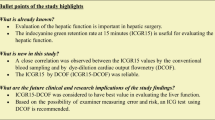Abstract
The influence of the intravenous injection of ranitidine (50 mg) on hepatic hemodynamics was investigated in normal subjects and patients with chronic liver disease. Using the organ-reflectance spectrophotometer, the regional hepatic blood hemoglobin concentration (ΔEr569–650), an indicator of the regional hepatic blood flow, and the oxygen saturation of hemoglobin in the regional hepatic tissue (So 2) were measured in patients with chronic liver disease after ranitidine injection under peritoneoscopy. With the pulse-Doppler ultrasonic flowmeter, the portal blood flow was measured in patients with chronic liver disease and normal subjects. There were no significant changes in the regional hepatic blood flow, the oxygen saturation of hemoglobin, and the portal blood flow after the intravenous injection of ranitidine. Thus, it is concluded that usual dose of ranitidine has no significant influence on the hepatic blood flow and that it can be prescribed without reducing the hepatic blood flow.
Similar content being viewed by others
References
Domschke W, Lux G, Domschke S: Potent inhibition of gastric acid secretion by a new type of histamine H2-receptor antagonist in man. Gastroenterology 76:1123, 1979
Kett K, Aadland E, Berstad A: Inhibition of gastric secretion in man with a new H2-receptor antagonist, ranitidine. Scand J Gastroenterol 15:249–251, 1980
Wieslaw P, Jague LL, Tepperman BL, Miller TA, Jacobson ED: Histamine H1 and H2 receptor vasodilation of canine intestinal circulation. Am J Physiol 233:E219–224, 1977
Feely J, Guy E: Ranitidine also reduces liver blood flow. Lancet 1:169, 1982
Grainger SL, Marigold JH, Keeling PWN: Ranitidine and liver blood flow. Lancet 1:398, 1982
Sato N, Hayashi N, Kawano S, Kamada T, Abe H: Hepatic hemodynamics in patients with chronic hepatitis or cirrhosis as assessed by organ-reflectance spectrophotometry. Gastroenterology 84:611–616, 1983
Hayashi N, Kasahara A, Kurosawa K, Sasaki Y, Fusamoto H, Sato N, Kamada T: Oxygen supply to the liver in patients with alcoholic liver disease assessed by organ-reflectance spectrophotometry. Gastroenterology 88:881–886, 1985
Jorgensen JE, Campau DN, Baker DW: Physical characteristics and mathematical modeling of the pulsed ultrasonic flowmeter. Med Biol Eng 11:404–421, 1973
Sato N, Shichiri M, Hayashi N, Kamada T, Abe H, Hagihara B: Behavior of cytochrome oxidase in living liver tissue.In Cytochrome Oxidase, King TE, Chance B, Okunuki B, Orii Y (Eds). Amsterdam, Elsevier/North-Holland Biomedical Press, 1979, pp 319–329
Domschke W, Lux G, Domschke S: Gastric inhibitory action of H2-antagonists, ranitidine and cimetidine. Lancet 1:320, 1979
Richardson CT: Effect of H2-receptor antagonists on gastric acid secretion and serum gastrin concentration. Gastroenterology 74:366–370, 1978
McGuigan JE: A consideration of the adverse effects of cimetidine. Gastroenterology 80:181–192, 1981
Speeg KV, Patwardhan RV, Avant GR, Mitchell MC, Schenker S: Inhibition of microsomal drug metabolism by histamine H2-receptor antagonists studiedin vivo andin vitro in rodents. Gastroenterology 82:89–96, 1982
Henry DA, MacDonald IA, Kitchingman G, Bell GD, Langman MJS: Cimetidine and ranitidine. Comparison of effects on hepatic drug metabolism. Br Med J 281:775–776, 1980
Charbon GA, Brouers HAA, Sala A: Histamine H1 and H2 receptors in the gastrointestinal circulation. Arch Pharmacol 312:123–129, 1980
Feely J, Wilkinson GR, Wood AJJ: Reduction of liver blood flow and propranolol metabolism by cimetidine. N Engl J Med 304:692–695, 1980
Cohn JN, Khatry IM, Groszmann RJ, Kotelanski B: Hepatic blood flow in alcoholic liver disease measured by an indicator dilution technique. Am J Med 53:704–714, 1972
Kamada T, Hayashi N, Kasahara A, Kurosawa K, Yoshihara H, Fusamoto H, Sato N, Abe H: Hepatic hemodynamics in patients with alcoholic liver injuries assessed by organ-reflectance spectrophotometry. Hepatology 3:1071, 1983
Schenk WG, McDonald JC, McDonald K, Drapanas T: Direct measurement of hepatic blood flow in surgical patients. Ann Surg 156:463–471, 1962
Tystrup N, Winkler K, Mellemgaard K, Andreassen M: Determination of the hepatic arterial blood flow and oxygen supply in man by clamping the hepatic artery during surgery. J Clin Invest 41:447–454, 1962
Kock NG, Hahnloser P, Roding B, Schenk WG: Interaction between portal venous and hepatic arterial blood flow: An experimental study in the dog. Surgery 72:414–419, 1972
Author information
Authors and Affiliations
Rights and permissions
About this article
Cite this article
Sasaki, Y., Hayashi, N., Kasahara, A. et al. Influence of ranitidine on hepatic blood flow assessed by organ-reflectance spectrophotometer and pulse-doppler ultrasonic flowmeter. Digest Dis Sci 30, 1043–1048 (1985). https://doi.org/10.1007/BF01315601
Received:
Revised:
Accepted:
Issue Date:
DOI: https://doi.org/10.1007/BF01315601




